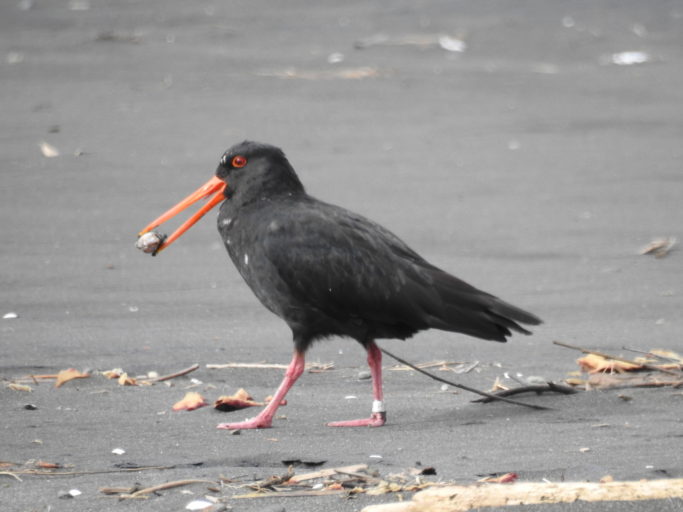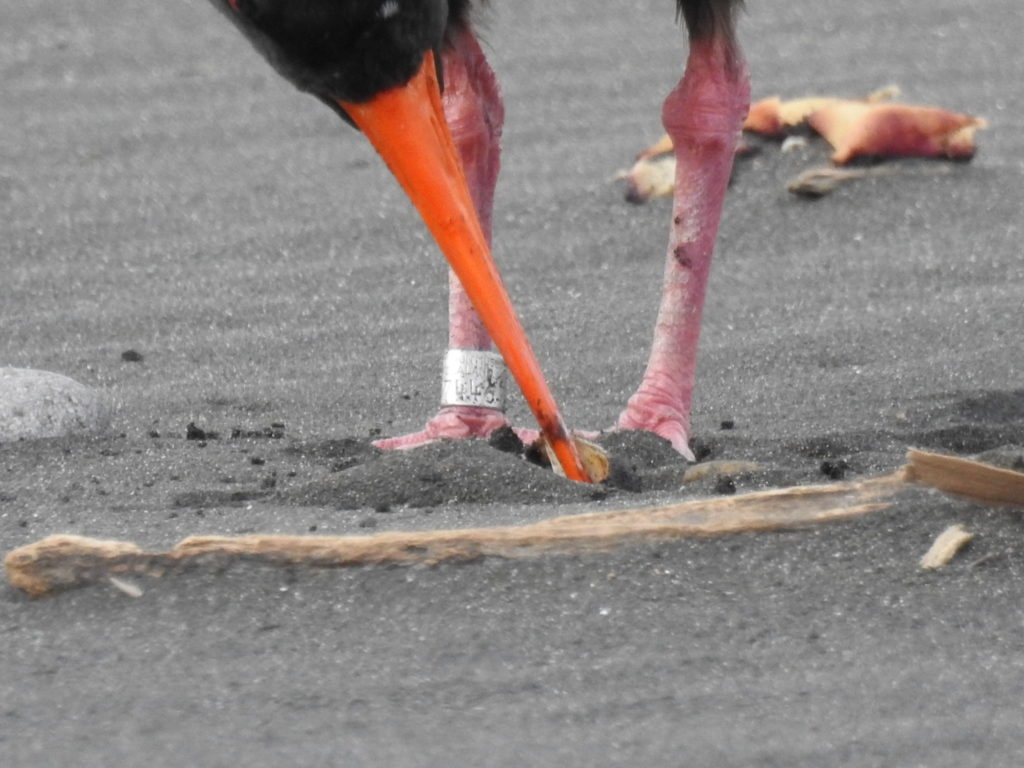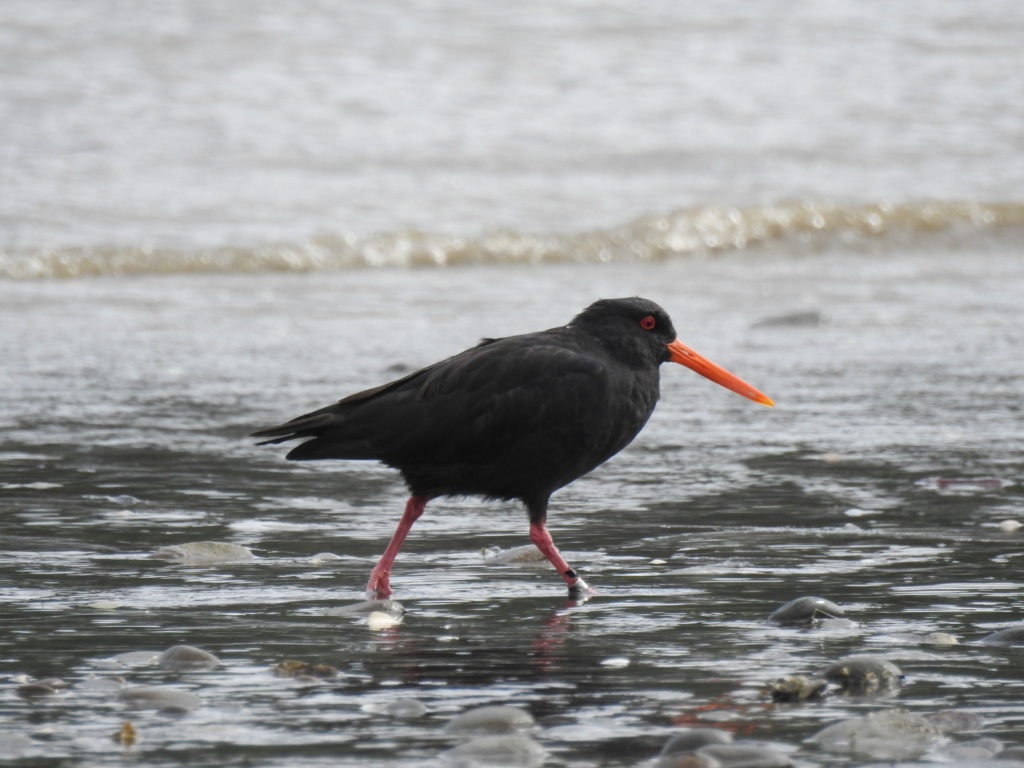How old can an old bird get? It depends on the species of course and the risks of predation and starvation and all the other hazards of a life lived wild. But assuming a bird lives to its ‘full term’ potential, what is ‘old’ in bird lifespans?

Parrots are often long-lived. Kakapo are believed to live for over 50 years and some may live to be 90. Kea can live into their 20s at least. Little birds like fantails, however, may live short, busy lives. Old age for fantails is believed to be about 5 years – and according to New Zealand Birds Online, an old tui would be about 12 years old and an old mohua might be around 16.
So what about oystercatchers? How long do you reckon an oystercatcher might live?
Well according to researchers, there’s an ID-banded variable oystercatcher (VOC) living in New Zealand that could be the 2nd-oldest known individual of any oystercatcher species globally. It’s identified by its band number, K-7446, and was banded by ornithologist, Ray Benfell, back in the 1980s.
K-7446 has been spotted again in the last year or so, with observations recorded in an article in ‘Notornis’, the research journal of Birds New Zealand (NZ Ornithological Society).
Co-author of the article, Emily Roberts from Taranaki Regional Council, spotted K-7446 on 27 April 2019, and read the metal band number (K-7446) from photographs of the bird foraging on the south side of the Mokau Estuary, on the Waikato-Taranaki boundary. She had seen what was, almost certainly, the same bird at the same location on 19 November 2017, but the complete band number was not read on that occasion.
“K-7446 was banded by Ray Benfell as a chick on Somes Island, Wellington Harbour on 2 January 1982. At the time of the 2019 sighting, the bird was therefore 37 years 4 months of age,” the authors report.
Many oystercatcher species around the world are known to be long-lived, including those in New Zealand.

“During his study of the species in the 1970s, Allan Baker banded a number of birds at Waipu Estuary, North Auckland. In the 1990s, some of these were re-captured and re-banded with new colour combinations by JED [John Dowding, co-author of the Notornis article]. Seven birds in this group were of known age, and five of them subsequently reached 31 years or more.”
The variable oystercatcher (Haematopus unicolor) is an endemic species found around much of the coastline of New Zealand.
“The population was estimated at about 2,000 birds in the early 1970s, but has increased rapidly since then, and more recent estimates are in the range 5,000–7,000 individuals. Under the New Zealand Threat Ranking Scheme, the species is currently ranked At Risk (Recovering); under IUCN criteria, it is ranked Least Concern.”
But K-7446 is a very old bird, even by oystercatcher standards.
“We believe K-7446 to be the oldest known oystercatcher of any of the three New Zealand species. The oldest South Island pied oystercatchers (H. finschi, SIPO) known were 21 years minimum, but given the annual adult survival value for the species, some SIPO may be expected to live longer. Two Chatham Island oystercatchers (H. chathamensis) have reached 30 years old; one was banded as an adult and reached 30 years minimum, and one banded as a chick was last seen at age 30 years 0 months.”

In fact, oystercatchers are so long-lived, they often outlive their colour bands!
“Colour bands on New Zealand oystercatchers typically last about 12–15 years before wearing through and being lost. Birds carrying a metal band only are more likely to be overlooked, so recapture and replacement of colour bands helps to determine maximum ages for these and other species that survive longer than a single set of colour bands.”
The authors provide some international age records for oystercatchers for comparison with K-7446 – and ‘K’ could be one of the oldest oystercatchers known.
“The most numerous and well-studied oystercatcher globally is the Eurasian oystercatcher (H. ostralegus). The oldest known individual of that species reached 43 years 4 months, with the second oldest 36 years 11 months. The oldest American oystercatcher (H. palliatus) was at least 23 years 10 months. In Australia, the oldest known pied oystercatcher (H. longirostris) was 32 years 2.3 months, and the oldest sooty oystercatcher (H. fuliginosus) was 25 years 6.7 months.”

So K-7446 is well up there at 37+ years old. But what’s ‘K’ been up to since 1982? Well this isn’t the first time its been sighted, so the authors know a little bit about the intervening years.
“The straight-line distance between the banding site [Somes Island] and the 2019 sighting is ~285 km. In 2004, Barry Hartley reported this bird to the Banding Office as ‘seen since February 1998 at Mokau and the metal band number recorded on 23 January 2004’. VOCs typically first breed at about 5 years old; as K-7446 was 16 years old in 1998, Mokau may not have been its first breeding site. The 2004 sighting was about 2.4 km north of the 2017 and 2019 sightings.”
Last seen a year ago, there’s every reason to hope that ‘K’ is still doing well, possibly somewhere around Mokau.
“The bird was not captured in 2019, so it was not possible to examine the band closely, but it appeared from photographs to be in good condition [see the original record logged on i-naturalist]. The entire inscription was legible, and there was no evidence of callousing or other injury to the bird’s foot. It is also evident from the photographs that the bird has a distinctive scattering of white feathers on its head and breast.”
Those white feathers should make K-7446 a little bit easier to spot if you’re birdwatching, even if you can’t read the legband number. If ‘K’ keeps going for a few more years it might even outlive the oystercatcher ‘world record’ of 43 years.
“Based on the records we have found, K-7446 appears to be the oldest oystercatcher of any of the New Zealand species, and is possibly the second oldest oystercatcher of any species globally. It was alive when sighted in April 2019, and appears to have been site-faithful for many years, so it will be interesting to monitor its further survival,” the authors conclude.
The full article in Notornis will be available to non-subscribers 1 year after publication – or check out your public library for access now.
Long-lived variable oystercatchers (Haematopus unicolor) (2019)
Find out how you can take part in the 5-year Bird Atlas Project currently underway around New Zealand. It started in June 2019.

